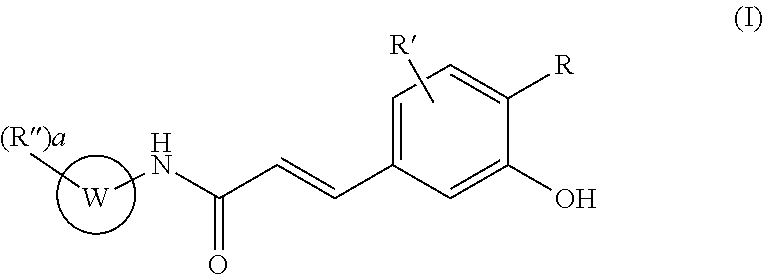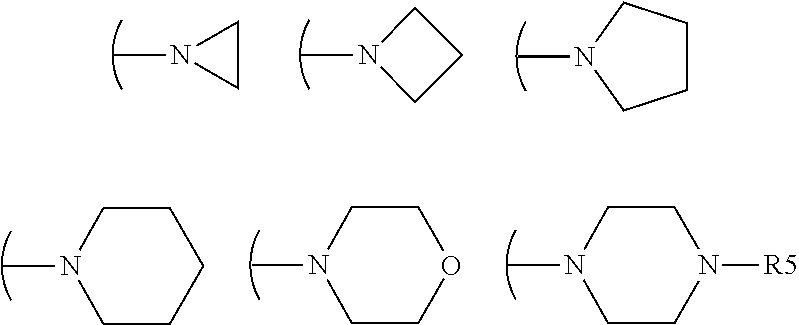Acrylamido derivatives useful as inhibitors of the mitochondrial permeability transition
a technology of acrylamide and derivatives, which is applied in the field of acrylamide derivatives, can solve the problems of swelling and eventual rupture of the outer mitochondrial membrane, and increased calcium uptake and ros production
- Summary
- Abstract
- Description
- Claims
- Application Information
AI Technical Summary
Problems solved by technology
Method used
Image
Examples
example 2
Preparation of substituted (E)-3-(3-hydroxy-phenyl)-acrylic anilides from the corresponding (E)-3-(3-acetoxy-phenyl)-derivatives by acid hydrolisis
[0399]
(11) (E)-N-[2-Chloro-3-(pyridin-4-ylmethoxy)-phenyl]-3-(3-hydroxy-4-methoxy-phenyl)-acrylamide hydrochloride
[0400]
[0401]A 3N methanolic solution of hydrochloric acid (10 ml, 30 mmols) is added to a solution of (E)-N-[2-chloro-3-(pyridin-4-ylmethoxy)-phenyl]-3-(3-acetoxy-4-methoxy-phenyl)-acrylamide hydrochloride (240 mg, 0.53 mmol) in THF (5 mL). The resulting mixture was stirred at RT for 16 hrs, concentrated under reduced pressure, taken up with solvent an re-evaporated (3 times with MeOH and once with acetone) to give a light yellow residue that was triturated with ethyl ether. After filtration and drying, 232 mg of the title (E)-N-[2-chloro-3-(pyridin-4-ylmethoxy)-phenyl]-3-(3-hydroxy-4-methoxy-phenyl)-acrylamide hydrochloride were obtained as a light yellow powder.
[0402]1H NMR (DMSO-d6) δ (ppm): 9.57 (s, 1H), 9.25 (bs, NH+), 8....
example 3
Preparation of substituted (E)-3-(3-hydroxy-phenyl)-acrylic anilides from the corresponding (E)-3-(3-hydroxy-phenyl)-acrylic acids
[0571]
(54) (E)-N-(3-Chloro-phenyl)-3-(3-hydroxy-phenyl)-acrylamide
[0572]
[0573]A solution of (E)-3-(3-hydroxy-phenyl)-acrylic acid (1.0 g, 6.1 mmol) and thionyl chloride (0.53 mL, 7.32 mmol) in dry THF (15 mL) was stirred at 55° C. for 3 hrs. Then a further aliquot of thionyl chloride (0.1 mL, 1.38 mmol) is added and the mixture is stirred at reflux temperature for additional 1.5 hrs. After cooling to about 5° C., a solution of 3-chloro-aniline (0.65 mL, 6.1 mmol) and triethylamine (3.4 mL, 24.4 mmol) in dry THF (5 mL) was added dropwise. After stirring at RT for 16 hrs the reaction mixture was diluted with DCM and washed with water, aqueous hydrochloric acid, and brine. The organic layer was dried over sodium sulphate and evaporated. The resulting raw material was purified first by column chromatography (eluant petroleum ether / AcOEt 45 / 55) and then by tri...
example 4
Preparation of substituted (E)-3-(3-hydroxy-phenyl)-acrylic anilides from the corresponding (E)-3-(3-acetoxy-phenyl)-acrylic acids
[0649]
(73) (E)-N-(3-Chloro-phenyl)-3-(4-fluoro-3-hydroxy-phenyl)-acrylamide
[0650]
[0651]A solution (E)-3-(3-acetoxy-4-fluoro-phenyl)-acrylic acid (0.17 g, 0.76 mmol) and thionyl chloride (0.069 mL, 0.95 mmol) in dry THF (2 mL) was stirred at 55° C. for 3 hrs. Then a further aliquot of thionyl chloride (0.008 mL, 0.11 mmol) was added and the mixture was stirred at reflux temperature for additional 1.5 hrs. After cooling to about 35° C., a solution of 3-chloro-aniline (0.204 mL, 1.90 mmol) dry THF (0.5 mL) was added dropwise. After stirring at RT for 16 hrs, the reaction mixture was diluted with DCM and washed with water, aqueous hydrochloric acid, and brine. The organic layer was then dried over sodium sulphate and evaporated. The resulting raw material was taken up without further purification with THF (2 mL), and a 3N methanolic solution of hydrochloric a...
PUM
| Property | Measurement | Unit |
|---|---|---|
| molecular mass | aaaaa | aaaaa |
| temperature | aaaaa | aaaaa |
| temperature | aaaaa | aaaaa |
Abstract
Description
Claims
Application Information
 Login to View More
Login to View More - R&D
- Intellectual Property
- Life Sciences
- Materials
- Tech Scout
- Unparalleled Data Quality
- Higher Quality Content
- 60% Fewer Hallucinations
Browse by: Latest US Patents, China's latest patents, Technical Efficacy Thesaurus, Application Domain, Technology Topic, Popular Technical Reports.
© 2025 PatSnap. All rights reserved.Legal|Privacy policy|Modern Slavery Act Transparency Statement|Sitemap|About US| Contact US: help@patsnap.com



